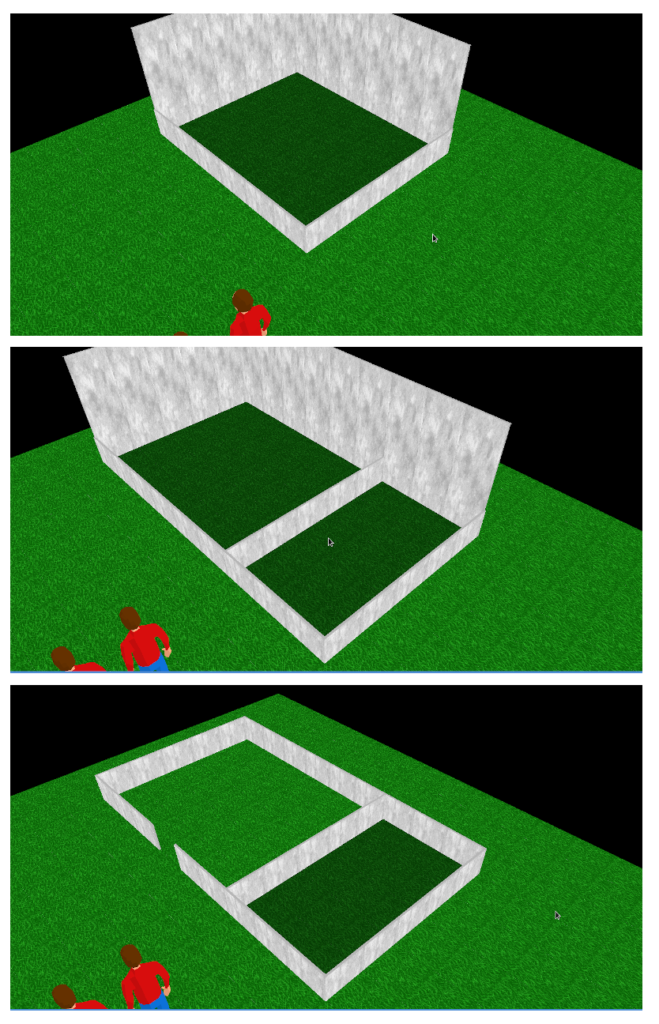Fix room destruction detection
Fixed a problem with the room detection when destroying rooms from the upper left that was discovered when working on the lighting. That’s it. 🙂
Ramblings about hobbyist game development
Fix room destruction detection
Fixed a problem with the room detection when destroying rooms from the upper left that was discovered when working on the lighting. That’s it. 🙂
Apply the tile local light information from the storage buffer to wall tiles (and simplify some of wall vertex draw code)
Relates to #46
Hi! Continuing the work on the previous commit, now not just the floor tiles, but also wall pieces properly use the globally available lighting data. The tricky part here was to map the vertex data to certain logical world tiles, as this is somewhat more complicated case than the floor tiles, which in their very nature are exactly that.. tiles. 🙂
Anyway, here’s wonderwall a short video of what that looks like in action:
Next up: doing the same for models, as they would still get the same global lighting information, even when standing in a room right now.
Introduces shader storage buffers to make world (lighting and temperature) information available on shaders and uses the information
Hello! While the commit message does not sound super exciting, this is actually the basis of any upcoming work for light/temperature visualisations, as a proof of concept this has been now implemented for a very narrow case: just for the floor tiles and not taking any artificial light sources into consideration.
What hasn’t changed since the last commit is the temporary implementation of the light calculation for rooms, which is just applying a static offset to whatever the “outside” value is.

As you can see here, as soon as a room is closed up the lighting of the floor tile changes, as well as changing back to the “outside” value as soon as it is opened back up again.
As mentioned above, this is only a proof-of-concept for now, so the next steps will be also applying the same data for wall tiles and models, both of which will require a different way to map them to to a given tile, in order to take lighting information from it. Once that basic functionality is working in all three cases (walls, floor and models), I will look into support artificial light sources, which should result in a single implementation for all three cases.
Not mentioned in the commit message were fixing a bunch of smaller bugs and some linting warnings. 🙂 Hopefully the next commit should be a matter of days, not weeks, like this one since a fair share of research and trying went into this one. I for one can’t wait to see this topic through to finally get some sorely needed visual improvements. 🙂
Add mostly dummy implemenation of per-room light and temperature calcualtions (adds most required variables and functions), the actual calculation per-room is the dummy part
Relates to #43
Hello! This pretty verbose commit message is basically saying just that, the proper “framework” of functions to introduce these new values (and update them) was added, values are also already calculated but their main characteristic is currently just to be “different from the outside values” in order to see if they update properly.
That being said they are obviously not used anywhere yet, so the next step is to actually make use of them, see what needs to get changed for that in the rendering process and finally do the proper calculations. 🙂
Add neighbour detection to Room Manager
Resolves #42
Hi! Extending the room system a bit further, now after modifying rooms (creating new ones by building walls or removing existing/merging existing ones by removing walls) the neighbours of each room is determined and saved.
This in itself is not helpful, but is needed as the basis for some upcoming topics. Bye!
Make wall auto hide mode depend on room detection
Resolves #41
Things appear to be moving quickly today, as mentioned in the previous post, the logic that decides whether a wall should be drawn in a “lowered” state has been changed from checking if a tile behind a wall is, well, not grass to check if it is actually in a room, meaning “not outside”.
While the initial approach worked “well enough” in most cases, the before and after screenshots below illustrate the crucial difference:


So before that change, you better did not forget to put tiles down on every outer tile or you would be unable to see what is behind. All better now. 🙂
Refresh room data when walls are being torn down
Resolves #22
Hello! The remainder of the work to complete the code was even less than I had anticipated, as such it’s time to give the code a proper test by using it in its first feature. Let’s hope no (bigger) issues pop up so that some new concepts can be built on top of it 🙂
Complete the room detection code (for building walls only, removal is WiP)
Relates to #22
Hi! This fully implements (at least after testing it for a few minutes and everything looked fine) the logic necessary to handle room detection after building new walls.
Below you will see three different scenarios, the first one is how it handles a room that was built on its own, the second case uses one of the existing walls and in the third, arguably most interesting, case is a new wall which separates the existing rooms (at once), which turns two detected rooms into four.



The text below each picture is just a screenshot taken from the log output. Next up, handling the removal of walls, which should be relatively quick and easy with this logic in place already. 🙂